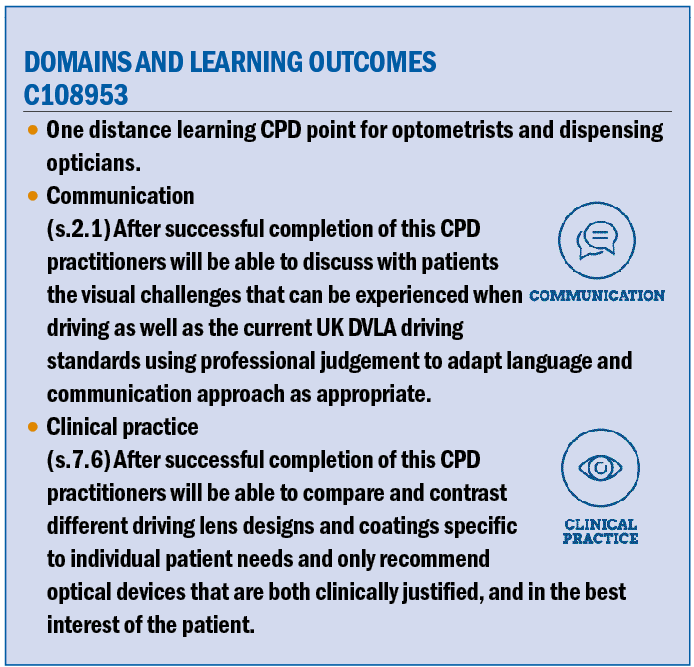
There are 50 million people in Great Britain that hold a driving licence and approximately 40 million licenced vehicles.1 Driving has become an essential part of daily life. This article provides insights into how drivers can maintain and improve their visual acuity and how today’s drivers face increasing challenges that may not have been faced a few years ago.
The Driver and Vehicle Licensing Agency (DVLA) minimum eyesight standards2 are shown in figure 1.
Figure 1: DVLA driving standards for Group 1 and Group 2 drivers
The Importance of Good Vision for Safe Driving
The facts, over 10 years ago, in a report to the Transport Select Committee Inquiry, the Optical Confederation highlighted evidence that suggested approximately 1.8 million drivers had vision below the minimum legal standard.3 In 2022, there were 176 collisions where uncorrected or defective vision was stated as a contributary factor, of which five resulted in fatalities.4
Road casualty figures have shown signs of a return to pre-pandemic trends, increasing compared to 2020 and 2021 when casualty numbers were low, largely as a result of periods of lockdown leading to a reduction in road traffic.5 In reported road collisions in Great Britain in 2022, the final estimates were:
- 1,711 fatalities, a decline of 2% compared to 2019.
- 29,742 killed or seriously injured casualties, a decline of 3% compared to 2019.
- 135,480 casualties of all severities, a decline of 12% compared to 2019.
In 2022, very few casualties were recorded on motorways, despite motorways accounting for a fifth of all road traffic in Great Britain, indicating that a person is less likely to be involved in a collision when travelling on a motorway compared to urban or rural roads.5
Clear vision is fundamental to safe driving. It enables drivers to make informed decisions, accurately judge distances, react to hazards, and interpret road signs and signals. Driving with impaired vision can lead to accidents, putting both the driver and others on the road at risk. In fact, poor vision is a significant factor in many road accidents,4 which is why the UK government has stringent vision-related regulations.
The Royal Society for the Prevention of Accidents (ROSPA) reported that 40% of accidents occur at night6 and in a survey of 900 drivers 46.7% reported difficulties when driving at night caused by other driver’s headlights.7
Many issues mentioned in this article such as glare, headlights, screen reflections, etc, are exacerbated during the hours of darkness and therefore more problematic during the late autumn through to early springtime.
Today’s drivers now face increasing challenges, for example, satellite navigation generally positioned in the centre of the dashboard, augmented reality (AR) guidance systems, and modern cars using high-intensity discharge (HID) or light-emitting diode (LED) headlights, which are much brighter than traditional halogen headlights.
In addition, faster cars (that accelerate and brake more quickly), dashboard details that are often smaller and certainly more numerous along with an increase in SUVs and 4x4 vehicles with associated higher positioning of the headlights.
Clearly the modern driver of any age will benefit from advice they are given at the time of an eye examination (or a visit to the practice) whether or not a prescription is given, required or changed. For patients struggling with nighttime driving, bright sun light, and glare there are MAR coatings, tinted and polarising lenses.8
A driver’s experience of day and nighttime driving is important and imperative in order to fully and correctly recommend and prescribe. Visual challenges of dim street lighting, glare from headlights, and often quick adaptation to a wide range of lighting levels are additional issues at nighttime.
Studies have shown that approximately one third of drivers over 45 years report nighttime driving difficulties9-11 and problems increase with age. Driving at night is one of the most commonly reported self-restrictions among older drivers, possibly due to a decline in vision that makes nighttime driving more challenging.11
Potentially the ‘older’ modern driver is also more likely to be impacted by age-related vision changes the proportion of drivers aged ≥70 years holding a full licence in 2022 was 73%, 20 years ago this figure was only 45%,1 which highlights the overall aging of the population is leading to an increase in the number of older drivers.
In the coming decades, around 95% of people aged 65 or over will be active drivers.12 Cataract, macular degeneration, glaucoma and diabetic eye disease – are all age-related conditions. To a lesser or greater extent these can affect driving vision especially if changes are not well monitored, which may allow modern lenses and/or coatings to be prescribed for improved driving, safety and potentially quality of life.
Effective patient communication is an essential part of daily clinical practice and a requirement of the General Optical Council (GOC) Standards of Practice for Optometrists and Dispensing Opticians13 when pathology is present it becomes even more important as this can impact visual ability and potentially a patient’s ability to meet the DVLA driving standards.
Dispensing the most appropriate optical appliance, which includes tints and coatings relevant to patient circumstances, work and lifestyle is crucial. Advice on caring for spectacles and coatings should not be overlooked as this helps ensure optimum visual performance.
Despite advice many people still drive with uncorrected refractive errors, a focus group study by Fylan et al (2018)14 found some participants felt safe enough to drive uncorrected despite road signs being clearer when wearing spectacles, others stating the optometrist had said it would be ‘beneficial’ to wear spectacles so they assumed they were safe to drive uncorrected.
Some participants found nighttime glare worse when wearing their spectacles and very few knew the minimum legal standards. Optometrists and dispensing opticians need to ensure the wording used in discussions regarding driving should be clear and not open to misinterpretation and that all discussions are documented on the patient record.
The RAC has recently published a study into headlight glare, finding 85% of those affected feel the problem is getting worse.15 Also causing 67% of these drivers to slow down considerably until their vision clears, which can take six seconds or more (11%). Sadly, only 6% of drivers experiencing difficulties had spoken to an optician about glare. On the plus side 25% of affected drivers said that an anti-reflection coating on their lenses is beneficial.
Let us have a closer look at some lens designs and coatings that now exist to improve the vision and visual experience of drivers.
Hoya
The Hoya Enroute lens collection is specifically crafted for driving, with a focus on enhancing the driving experience, minimising glare and reflections caused by oncoming traffic and streetlights and providing improved contrast and brightness during low light driving conditions. In a single blind crossover study under glare conditions Enroute lenses showed an improved best corrected visual acuity compared to clear lenses.16
This range offers two options:
- EnRoute is tailored to meet the needs of everyday and occasional drivers and is available in single vision and progressive lenses.
- EnRoute Pro is designed for driving enthusiasts or professional drivers, also available in both single vision and progressive lenses.
EnRoute17
Single vision and progressive options include a premium anti-reflection coating that minimises residual blue/lilac reflections, reducing glare from high-energy light scatter. This reduction in glare contributes to decreased eye fatigue and minimises ghost images. Additionally, the back surface is optimised with aspheric/atoric prescription design to enhance the binocular field, supporting spatial awareness for driving.
EnRoute progressive lenses17 (in addition) incorporate patented designs, Integrated Double Surface Technology (separating surface lens geometry into horizontal and vertical components) and Balanced View Control (Hoya 3D technology) providing wider visual fields, fast switching between distances and stable image perception minimising the ‘swim’ effect (figure 2).
Figure 2: Hoya Enroute lenses

EnRoute Pro17
Includes a contrast-enhancing filter with a brown-yellow tint of 10-12% absorption and a progressive design tailored for the dashboard distance, with adjustments made to the Add value. A helpful table for this modification is included in the lens detail. For single vision lenses, each prescription is individually optimised.
Both EnRoute and EnRoute Pro are offered in 1.6 and 1.67 indices. In addition to the standard EnRoute design, EnRoute Lite is also available, featuring Sensity Dark Technology along with a special anti-reflection coating.
Fitting criteria
Single vision lenses should be fitted as aspheric lenses for example monocular centre distances and heights, not forgetting to adjust for pantoscopic tilt by reducing heights from pupil centre by 1mm for every two degrees. Progressive lenses EnRoute and EnRoute Pro require a minimum fitting height of 19mm with a minimum of 10mm to upper rim.
EnRoute Pro requires vertex distance to be measured alongside pantoscopic angle and face form angle. Also, the reading addition should be modified for dashboard distance (a guide for this is provided by Hoya).
Zeiss
Zeiss emphasises the challenges posed by difficult light and weather conditions, including rain, mist, dusk and nighttime driving as significant concerns for many drivers as they can cause discomfort and vision impairment.18
As mentioned earlier in this article, the most common visual challenges during driving include poor visibility in low-light situations such as rain, dusk or night, glare from oncoming cars at night, dazzle from wet roads and difficulty in refocusing when shifting between the road and dashboard.
On average, 83% of spectacle lens wearers drive,16 which highlights the importance of addressing these challenges for a safer driving experience. Zeiss DriveSafe lenses have been designed to improve driver safety and comfort behind the wheel.
The lens features Luminance Design Technology (LDT), which takes into account differing light conditions and pupil sizes to improve the lens design for natural vision at all times.18,19
LDT incorporates the pupil size for driving in mesopic conditions and optimises the lens design accordingly: the adapted pupil sizes used in the optimisation algorithms are 5.0mm in single vision lenses and 4.3mm in progressive lenses. This gives better vision in low-light conditions (figure 3).
Figure 3: Zeiss DriveSafe Lenses Luminance Design Technology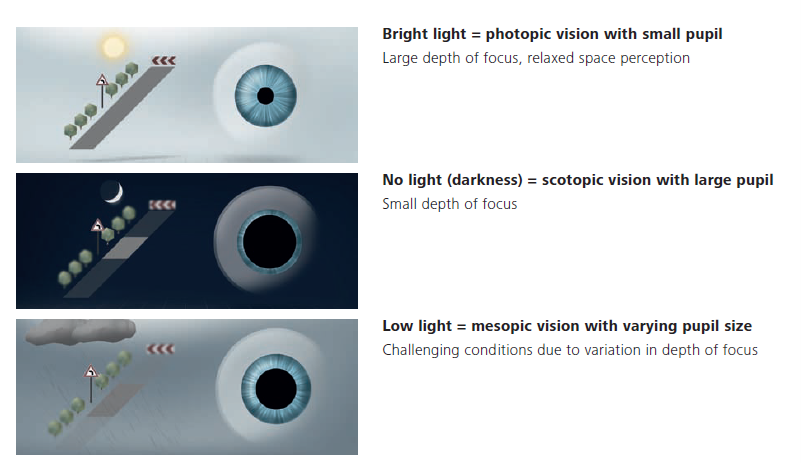
Zeiss DuraVision DriveSafe coating identifies the issue of car headlights at night where LED and HID bulbs enhance glare. In partial reflection of wavelengths in the range 400-450nm according to Zeiss data a reduction of perceived glare of 64% (compared to premium AR coatings) is achieved with this Zeiss coating.20
ZEISS DriveSafe Lens Design
Driving involves gaze direction changes as well as differing accommodation and convergence requirements. Zeiss commissioned a study by the Research Institute of Automotive Engineering and Vehicle Engines Stuttgart (FKFS) to understand the driver’s visual behaviour and eye tracking, which identified that for 97% of recorded time drivers watch the road, 2% viewing the dashboard and 1% switching between mirrors.18
The Drive Safe Progressive through optimised distance and intermediate areas reduces the need for side-to-side head movement resulting in a potential 43% larger mid distance zone and up to 14% far distance visual zone (in comparison to its own premium progressives).20
Fitting criteria
The single vision version should be fitted on pupil centre with the optical centre placed 4mm below fitting cross. The single vision individual with bespoke measurements is decentred according to the measured pantoscopic angle.
The Drive Safe progressive heights should be measured to pupil centre with controlled corridor lengths from 10mm to 20mm (minimum fitting heights 14mm to 20mm – note Zeiss information on FrameFit). The Drive Safe Individual is a more bespoke option with additional measurements required.
Indizen Optical Technologies IOT
IOT identifies driving as a ‘complex task that requires specific visual skills’ whether this is reacting to traffic signals, traffic lights, pedestrians and other vehicles. Recent surveys point out that peripheral vision appears to play a more critical role for safe driving.21
During nighttime driving, individuals may encounter night myopia, a condition where the eye becomes nearsighted in low light conditions due to changes in the eye’s refractive properties. Indications are that this amount is an average mean spherical refraction decrease of -0.27D.22
IOT report that at night, the area of fixation becomes smaller compared to daytime driving, and the eye tends to fixate at a lower level. These phenomena can be attributed to reduced visibility and increased reliance on headlights.23 Evidently, drivers tend to focus on more distant points during the day compared to their focus during nighttime driving.
Endless Drive Progressive – This innovative design integrates a night myopia optimised zone, a 180° distance zone, and an intermediate zone that is 45% larger (focused at 4m).24 The progression profile features an additional minus power (up to 0.25D) at the top of the lens, aiming to enhance the quality of the driver’s distance vision during nighttime.
An adjustment in astigmatic distribution allows a reduction of 14.6% in maximum astigmatism compared to a standard premium progressive lens with a balanced power distribution25 (figure 4). This modification contributes to an expanded visual field for distance vision.
Figure 4: Cylinder power distribution maps showing Endless Drive progressive on the left and standard premium lens on the right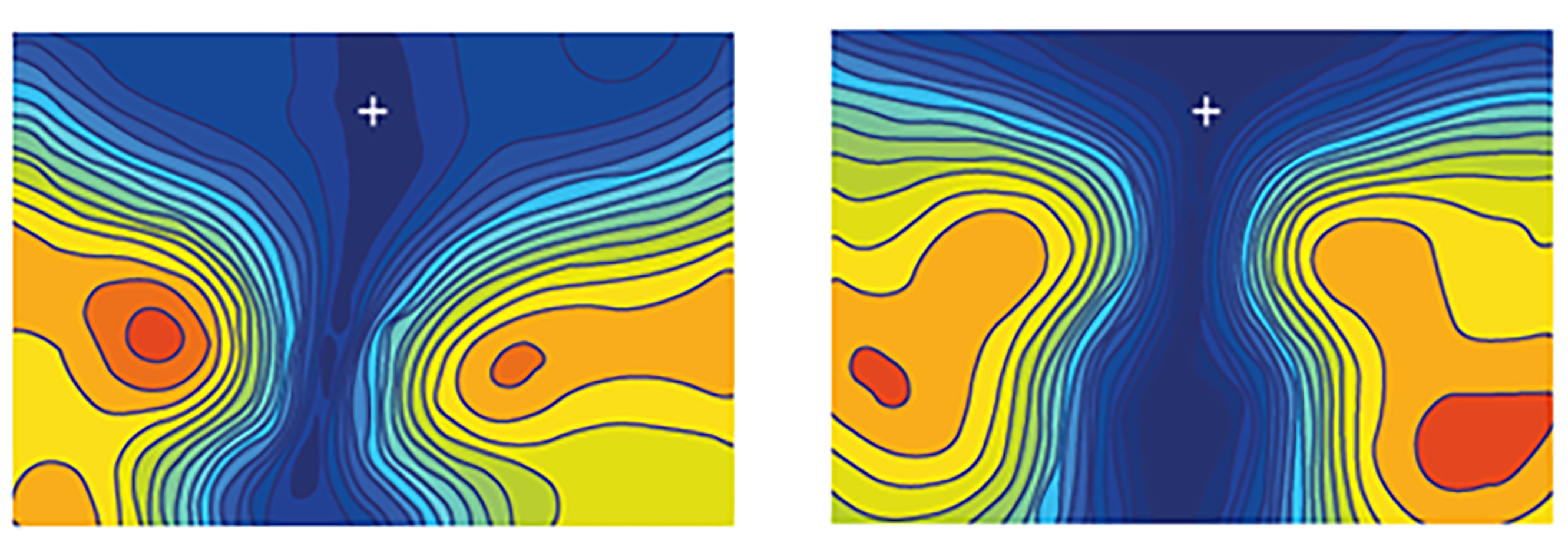
Endless Drive single vision – A freeform design lens also incorporates the additional minus power together with clear vision from centre to edge thanks to Digital Ray Path Technology.25
Endless Drive Coating – This specialised coating regulates the extent of light obstruction for blue-violet light. The coating exhibits intelligent selectivity across various wavelengths. Specifically, it blocks 86% of light at 400nm, 18% at 430nm, and decreases to 13% at 450nm.25
Consequently, the coating prioritises blocking the shortest wavelength, which significantly influences visual perception sensitivity. Conversely, it allows higher transmittance for longer wavelengths, minimising deterioration of visual perception – an approach aimed at optimising overall visual experience.
Fitting criteria26
Minimum fitting height is 18mm, IOT recommends leaving 1-2mm more to ensure a wide reading area. Lenses can be ordered with default settings or fully optimised with mono PDs on pupil centre, pantoscopic angle, frame vertex distance and face form angle (note face form angle is a frame measurement not an as worn measurement).
These lenses are available in any index with photochromic/drivewear.
Seiko2
Seiko identify up to 50% of drivers experiencing less than optimal vision while driving – specifically distortion of the wing mirror, assessing distances, difficulty with instrument panel vision and the insecurity of driving in dim light and the dark due to headlight glare.
Seiko Road Clear Coat (RCC) is described as an anti-reflection coating specifically crafted to address the challenges encountered while driving, especially at night. Seiko has pinpointed 507nm, which is more towards the blue end of the spectrum, as the most sensitive wavelength for the human eye at night, contrasting with 555nm during daylight.27
The RCC repels dust, oil, and is easy to clean, the glare reduction, very low reflectance and excellent transmittance specifically tailored for nighttime conditions. The reflection curve of RCC reaches its minimum at approximately 495nm, aligning closely with the peak sensitivity of rod cells at 498nm. This synergy results in clear vision and optimal perception in low-light conditions.27
Moreover, RCC takes note of the reflection in the blue spectral range, enhancing contrast vision and diminishing glare improving the driving experience.
Seiko Drive and Drive X
The Seiko Drive is an optimised aspheric single vision lens adapted for the needs of drivers. Seiko Drive X progressive provides large distance and intermediate zone ideal for dashboard viewing.
Seiko Concave-Convex-Combination-Slim (CCCS) technology and smooth astigmatism gives clear distance and a large intermediate zone allowing for safe and relaxed driving.
Through multi aspheric design and optimization offers sharpness of vision extending ‘up to the edges’. Seiko Drive and Drive X is available in 1.50, 1.60, Tribrid and 1.67 - clear polarising and photochromic availability (not all indices).
Fitting
Minimum fitting height of 23mm for Drive X with an inset of 2.50mm.
Regular pantoscopic angle of 8-12°.
Rodenstock28
Using personalised biometric data (Biometric Intelligent Glasses (BIG) BIG EXACT and BIG NORM) with measurements from their DNEye scanner including axial length, corneal power and thickness, anterior chamber depth, pupil size, crystalline lens power and vitreous chamber depth.28
This alongside position of wear measurements enables a personalised progressive lens design to be produced. The Road design lens was primarily developed to meet driving requirements but is also well-suited for everyday use.
Solitaire Protect Road 2 encompasses all the advantages of a premium anti-reflective coating, coupled with a 12% absorption tint reducing glare at night and enhancing contrast during the day. On the other hand, Solitaire Protect Road 2 X-tra Clean goes a step further by incorporating an X-tra clean finish, making it nearly impossible for dirt to adhere to the lens.
The Solitaire Protect Road Sun 2 combines a 75% brown tint reducing glare in strong sun light (also available with X-tra clean finish.)
Fitting criteria
Monocular optical centres and vertical heights.
Frame vertex distance.
Pantoscopic tilt.
Shamir Driver Intelligence
By leveraging Big Data collection tools and harnessing the analytical capabilities of the Shamir Artificial Intelligence-tooled Engine, valuable insights were gained into the crucial elements of the lens essential for achieving optimal driving vision.29 This research includes a comprehensive list of visual challenges and led to a lens finely tuned to meet the precise visual needs of drivers.
The Shamir research and development team interviewed 130 presbyopes aged 40-80 years to understand their visual needs, which led to the creation of Shamir autograph intelligence lenses. This unique design minimises head movement, thereby improving the freedom of eye movement. This, in turn, enhances comfort and safety while driving (figure 5).
Figure 5: Shamir driver intelligence lenses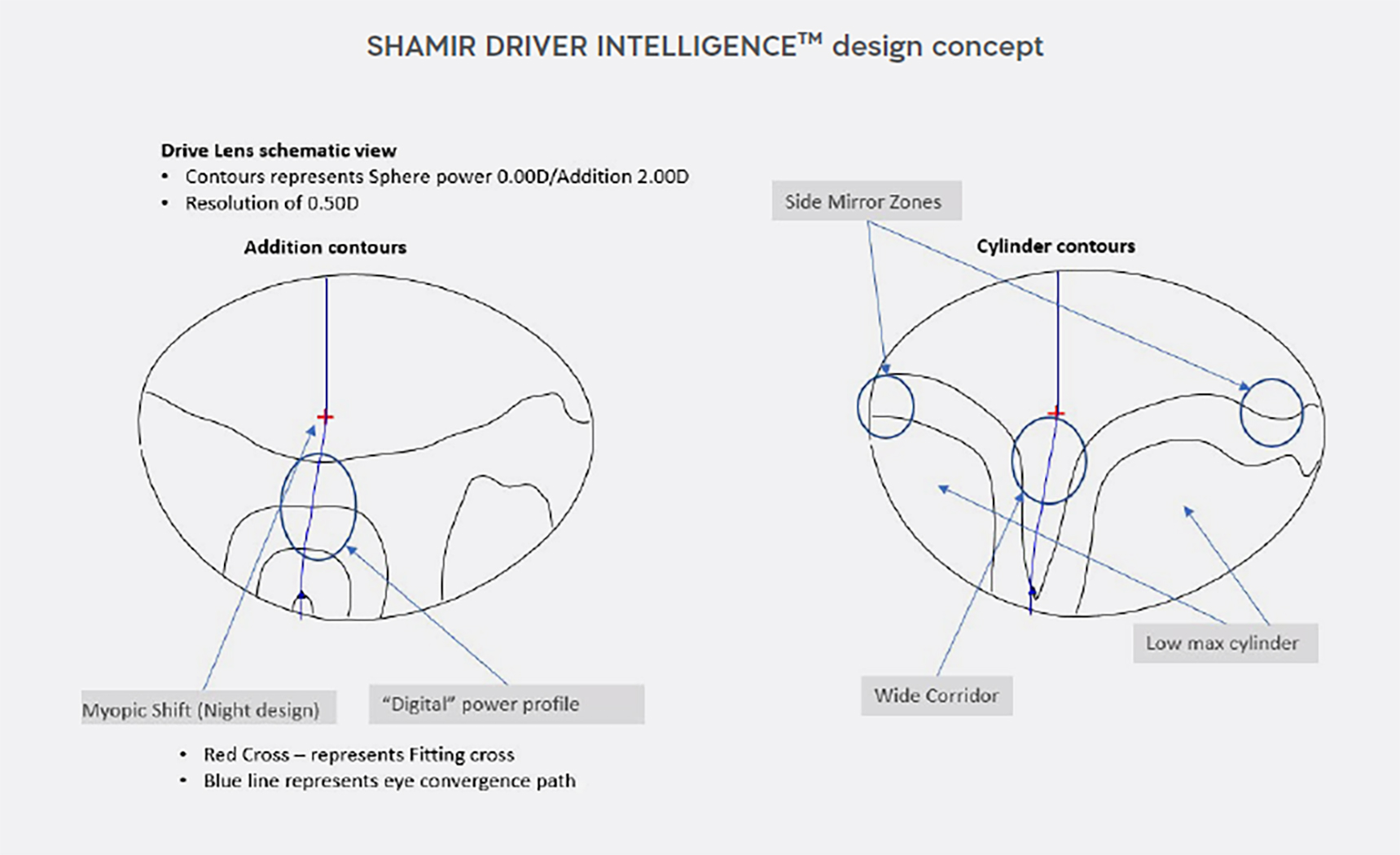
The design features a minimised maximum level of aberrations (cylinder), a broad corridor, an expansive far field of view and a power profile that aligns more effectively with driving characteristics. Shamir Glacier Sun UV and Shamir Glacier Expression are chosen coatings for daytime and nighttime/low light wear respectively.
Glacier Sun UV aims to reduce glare and provide UV protection. A neutral colour tint is employed so as not to affect the perceived veiled glare colour gamut. Glacier Expression with angular reflectance and ultra-low luminance reflectance, offers an optimal coating to reduce visual disturbance from reflections in a car environment.
Fitting criteria
Monocular optical centres and vertical heights.
Frame vertex distance.
Pantoscopic tilt.
Essilor
There is no specific lens design, but Essilor provide a Crizal Drive anti-reflection coating which is available with Eyezen and Varilux comfort Max lenses. Essilor draw attention to the many light sources that can cause reflections and glare at night and that under mesopic conditions it is the rod cells that are responsible for neural transmissions.
Reflections and glare can disrupt these rod cells and impact visual acuity (VA). Pupil dilation occurs in mesopic conditions which reduces depth perception as well as VA. A key point at night is the need to detect low contrast objects, which is more difficult as contrast sensitivity is reduced with lower peak sensitivity and spatial frequencies.30
Figure 6: Crizal Drive reflections and night and day eye sensitivity
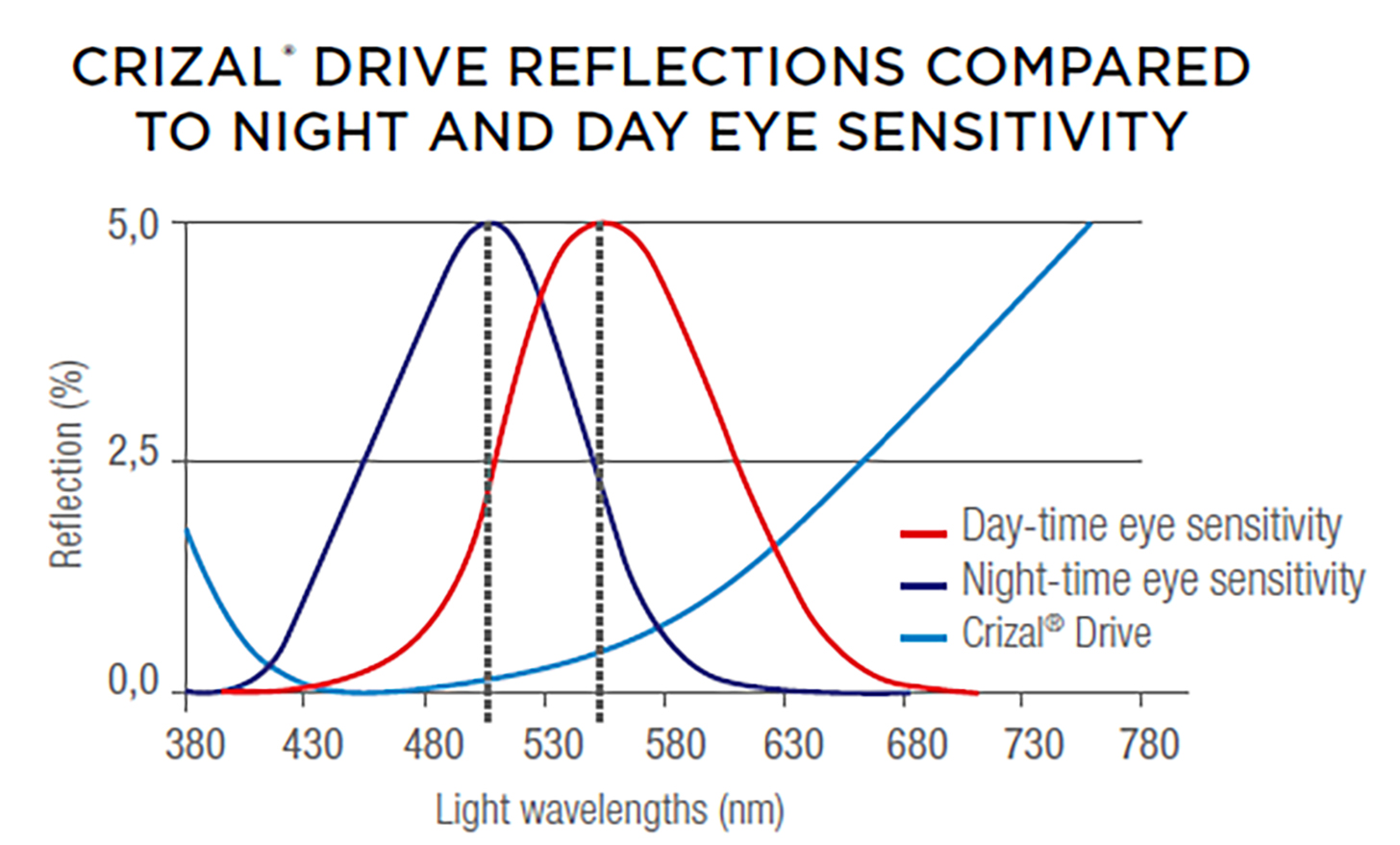
Essilor states that ‘minimising the level of reflections helps to maintain our visual acuity throughout the day and night’. Due to the coating performance reflections are up to 90% less when driving at night (versus a standard hard coated lens with no anti-reflective coating).30
Crizal Drive represents an advanced anti-reflective coating, providing exceptional clarity of vision by dynamically adjusting to the specific light waves detected by the eyes, both in daylight and nighttime conditions.
This results in a reduction of up to 40% in reflections during nighttime driving in low lighting, while maintaining comparable efficacy to Crizal Forte during the day. This contributes to enhancing vision and driving experience.
Furthermore, Crizal Drive offers resistance to scratching, easy to clean, and has water repellence and UV protection with an E-SPF of 35. This mirrors the quality features present in other Crizal products.
Nikon
There is no specific lens option but Nikon SeeCoat Drive anti-reflection coating has a glare reduction filter resulting in less glare when driving both at day and night, and enhanced contrast in low light conditions.
Yellow tints
Although heavily advertised for many years, Hwang et al (2019)31 found that wearing a yellow tint did not improve the negative effects of headlight glare or pedestrian detection and concluded that the findings of their study did not support eye care professionals advising patients to use yellow tinted lenses for night driving.
Although not statistically significant results showed the effect of so called ‘night glasses’ may slow down visual reactions by a fraction of a second. Please note that yellow lenses do improve contrast in certain situations in day light conditions due to its ability to absorb some blue light. If these are polarised lenses they will reduce glare as well.
Conclusion
The challenges facing today’s drivers are clear; dispensing opticians and optometrists have a duty of care to advise patients regarding their visual fitness to drive but also to advise on the available lens and coating options considering individual health and lifestyle requirements.
It is vital to gather information on frequency, where, when and duration of driving to then identify if (and how) lens coatings and technology or other optical solutions could result in more confident and safe driving. Patients can then make an informed decision as to the best dispensing solution for their individual needs.
I hope this article has highlighted why drivers may need ‘enhancement’ of their vision whether that be during the day, a long journey or driving after dark together with possible lens designs/coatings options. Some patients may well be aware of experiencing difficulty in driving, and with your knowledge you just may find a solution that gives them more visual comfort and therefore confidence in this important task.
Thanks to the companies who have allowed me to use their information and images in this article. Readers are advised to contact the companies mentioned for further detail on products and ranges mentioned in this article.
- Kevin Gutsell FBDO(Hons)SLD qualified in 1987 working in practice before joining Alcon in 1996 as an area account manager. In 1998 he joined Nikon Optical UK undertaking roles in sales, marketing and professional services until his departure in 2013. Gutsell now runs his own business (Optical Centre Supplies Ltd) and is the distributor of Centrostyle products in the UK. Gutsell has been a distance learning tutor for ABDO College since 1992 and is a member of the GOC Education Visitor Panel. He is the ABDO Spectacles Committee representative for BSI and has been an ABDO Board member for most of the last 14 years. Gutsell is now the president of ABDO.
References
- Department of Transport. Plan for drivers. Available from: https://www.gov.uk/government/publications/plan-for-drivers/the-plan-for-drivers . [Accessed December 21, 2023]
- Driver and Vehicle Licensing Agency. Visual disorders: assessing fitness to drive. https://www.gov.uk/guidance/visual-disorders-assessing-fitness-to-drive#:~:text=The%20minimum%20field%20of%20vision,50%C2%B0%20left%20and%20right [Accessed 21st December 2023]
- UK Parliament Transport Select Committee. Written evidence from Optical Confederation. UK Parliament. 2011. https://publications.parliament.uk/pa/cm201213/cmselect/cmtran/506/506vw24.htm
- Department of Transport. RAS0701: Reported road collisions casualties and severity 10 years up to 2022. https://www.gov.uk/government/statistical-data-sets/reported-road-accidents-vehicles-and-casualties-tables-for-great-britain [Accessed December 21 2023]
- Department of Transport. Reported road casualties Great Britain, annual report:2022. https://www.gov.uk/government/statistics/reported-road-casualties-great-britain-annual-report-2022/reported-road-casualties-great-britain-annual-report-2022#:~:text=In%20reported%20road%20collisions%20in,of%2012%25%20compared%20to%202019 [Accessed December 21, 2023]
- The Royal Society for the Prevention of Accidents. Driving at Night Factsheet. Birmingham. ROSPA. 2020. https://www.rospa.com/media/documents/road-safety/factsheets/driving-at-night-factsheet.pdf [Accessed December 21, 2023]
- Sukru K., Gyi DE., Mansfield NJ. Driving a better driving experience: a questionnaire survey of older compared with younger drivers. Ergonomics. 2017;60(4). https://doi.org/10.1080/00140139.2016.1182648
- British Standards Institution. 4. BS EN ISO 12312-1:2022. Eye and face protection – sunglasses and related eyewear. London: BSI; 2022.
- Kimlin JA, Black AA, Wood JM. Nighttime Driving in Older Adults: Effects of Glare and Association with Mesopic Visual Function. Invest Ophthalmol Vis Sci 2017;58(5):2796-2803. https://doi.org/10.1167/iovs.16-21219
- Gilhotra JS, Mitchell P, Ivers R, Cumming RG. Impaired vision and other factors associated with driving cessation in the elderly: the Blue Mountains Eye Study. Clin Exp Ophthalmol 2001;29(3):104-107. https://doi.org/10.1046/j.1442- 9071.2001.00411.x
- Naumann RB, Dellinger AM, Kresnow MJ. Driving self-restriction in high-risk conditions: How do older drivers compare to others? Journal of Safety Research. 2011; 42(1): 67-71. https://doi.org/10.1016/j.jsr.2010.12.001
- Rosenbloom, S. Sustainability and automobility among the elderly: An international assessment. Transportation. 2001 ; 28 : 375-408.
- General Optical Council. Standards of Practice for Optometrists and Dispensing Opticians. 2. Communicate effectively with your patients, 2.1,2.5. 2016. London: General Optical Council. P 7.
- Fylan F, Hughes A, Wood J, et al. Why do people drive when they can’t see clearly? Transportation Research Part F: Traffic Psychology and Behaviour. 2018;56: 123-133. https://bradscholars.brad.ac.uk/bitstream/handle/10454/16123/Elliott_TRF.pdf?sequence=3&isAllowed=y
- RAC Media Centre. A glaring problem: RAC Calls for action on headlight glare as eight-in10 drivers affected say problem is getting worse. Available from: https://media.rac.co.uk/pressreleases/a-glaring-problem-rac-calls-for-action-on-headlight-glare-as-eight-in-10-drivers-affected-say-problem-is-getting-worse-3296130 [Accessed February 18, 2024]
- Cozza F, Compagnoni M, Airoldi C, Braga C, et al. The effects of two longpass filters on visual performance. Journal of Optometry. 2020; 13(2): 102-112. https://doi.org/10.1016/j.optom.2019.07.001
- Hoya Vision Care. Specialty lenses Enroute. Available from: https://www.hoyavision.com/uk/vision-products/speciality-lenses/enroute/ [Accessed April 24, 2024]
- Zeiss.com. Press release, Zeiss Makes Car Driving Safer 2015. Available from: https://www.zeiss.com/content/dam/Vision/Vision/International/Pdf/en/newsroom/2015-10-05-press-release-drivesafe-long-version.pdf [Accessed 24th April 2024]
- ZEISS data on file. Market research study (August 2013) with ECPs & consumers with 480 participants in USA and Germany.
- Zeiss. Zeiss DriveSafe Lenses. Available from: https://www.zeiss.co.uk/vision-care/eye-care-professionals/lenses/lenses-for-every-need/lenses-for-driving.html [Accessed April 24, 2024]
- Fuller R, Santos J. Human Factors for Highway Engineers. Amsterdam: Pergamon Press; 2002
- Cohen Y, Zadok D, Barkana Y, et al. Relationship between night myopia and night-time motor vehicle accidents. Acta Ophthalmol Scand 2007; 85:367-370.
- Brimley BK, Carlson PJ, Hawkins HG. Use of Fixation Heat Maps to Evaluate Visual Behavior of Unfamiliar Drivers on Horizontal Curves. Transport Res Rec 2014;16-26.
- IOT. Endless Drive Progressives. Available from: https://iotlenses.com/Discover-our-lenses/Progressive-solutions/Endless-Drive-Progressive.html [Accessed April 24, 2024]
- Chamorro E, Alonso J, Crespo D. White paper Enjoyable Driving, Anytime. IOT. Spain. [Accessed April 24, 2024]
- IOT. Endless Drive Progressives. Available from: https://iotlenses.com/Discover-our-lenses/Progressive-solutions/Endless-Drive-Progressive. [Accessed April 24, 2024]
- Seiko. Lenses, Drive. Available from: https://www.seikovision.com/uk/lenses/drive/ [Accessed April 24, 2024]
- Rodenstock. B.I.G. EXACT. Available from: https://www.rodenstock.com/uk/en/big-exact.html#:~:text= Rodenstock’s%20B.I.G.%20EXACT%E2%84%A2%20lenses,perfectly%20together%20with%20your%20brain. [Accessed April 24, 2024]
- Shamir. White Paper Shamir Autograph Intelligence. Available from: https://info.icarelabs.com/hubfs/Shamir%20Autograph%20Intelligence%20White%20Paper.pdf [Accessed 24th April 2024]
- Essilor. Crizal Drive. Available from: https://ecp.essilor-pro.com/gb/essilor-lenses/lens-coatings/crizal-drive [Accessed April 24, 2024]
- Hwang AD, Tuccar-Burak M, Peli E. Comparison of Pedestrian Detection with and Without Yellow-Lens Glasses During Simulated Night Driving with and Without Headlight Glare. JAMA Ophthalmol. 2019;137(10):1147–1153. doi:10.1001/jamaophthalmol.2019.
- Wood JM. Nighttime driving: visual, lighting and visibility challenges. Ophthalmic and Physiological Optics. 2019; 40(2):187-201. https://doi.org/10.1111/opo.12659
